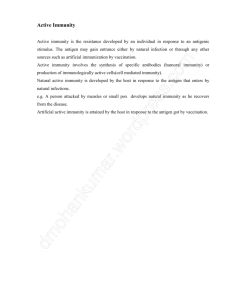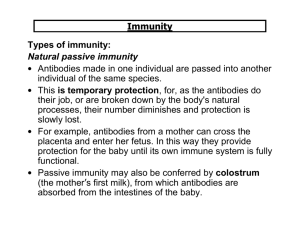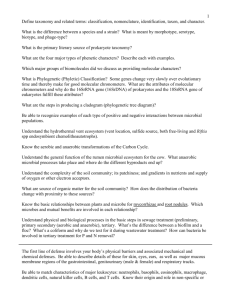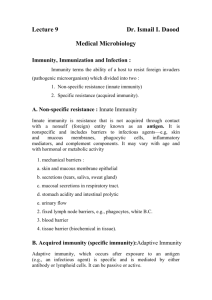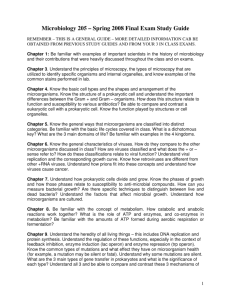15 to 18 year old Vaccination Lesson Plan Introduction This lesson
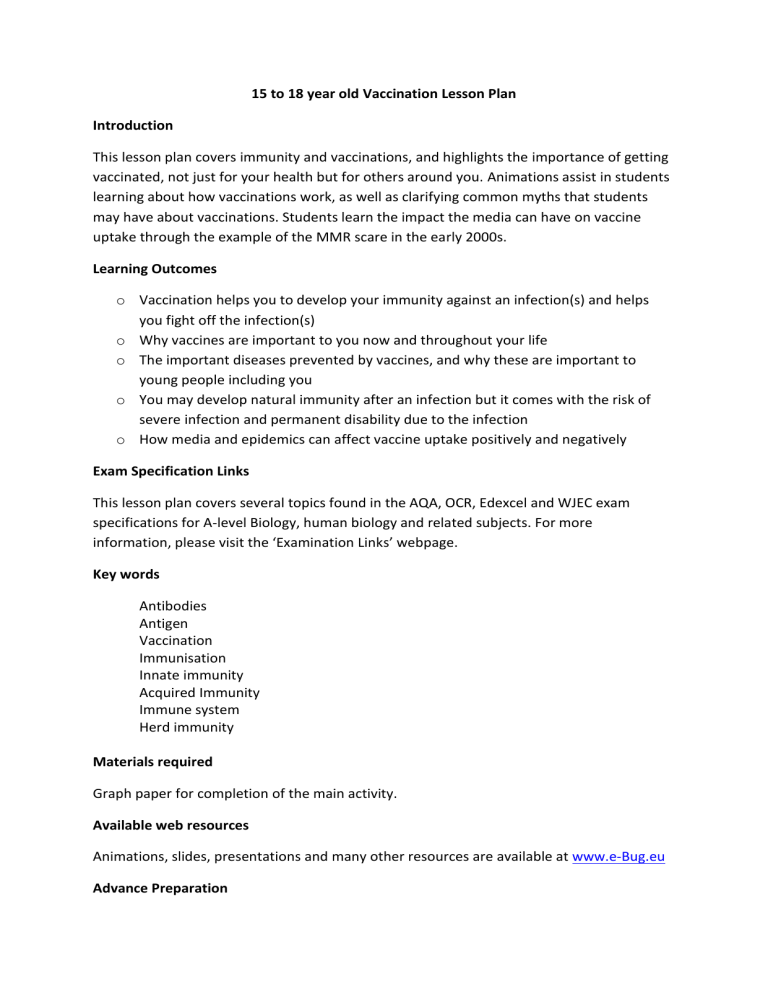
15 to 18 year old Vaccination Lesson Plan
Introduction
This lesson plan covers immunity and vaccinations, and highlights the importance of getting vaccinated, not just for your health but for others around you. Animations assist in students learning about how vaccinations work, as well as clarifying common myths that students may have about vaccinations. Students learn the impact the media can have on vaccine uptake through the example of the MMR scare in the early 2000s.
Learning Outcomes o Vaccination helps you to develop your immunity against an infection(s) and helps you fight off the infection(s) o Why vaccines are important to you now and throughout your life o The important diseases prevented by vaccines, and why these are important to young people including you o You may develop natural immunity after an infection but it comes with the risk of severe infection and permanent disability due to the infection o How media and epidemics can affect vaccine uptake positively and negatively
Exam Specification Links
This lesson plan covers several topics found in the AQA, OCR, Edexcel and WJEC exam specifications for A-level Biology, human biology and related subjects. For more information, please visit the ‘Examination Links’ webpage.
Key words
Antibodies
Antigen
Vaccination
Immunisation
Innate immunity
Acquired Immunity
Immune system
Herd immunity
Materials required
Graph paper for completion of the main activity.
Available web resources
Animations, slides, presentations and many other resources are available at www.e-Bug.eu
Advance Preparation
Locate the vaccination myths and misconceptions animations at www.e-Bug.eu
, and download the PowerPoint.
In preparation for the lesson, you can ask students to complete their own personalised vaccination timeline, available at www.e-Bug.eu
. This timeline will detail all the vaccinations students should have had, and they can discuss this at home with their parents. However, the immunisations that students have or have not had are not for class discussion. Students may be very surprised at the amount of immunisations they have had.
Background Information
Vaccinations have been one of the most effective methods to prevent disease and have helped to lower mortality associated with infectious diseases across the world.
How vaccines provide immunity
Vaccines are preventative, that is, they only protect the individual before they get a disease.
When an individual is vaccinated, the processes in the immune system that are stimulated to mimic the body’s natural immunity include antigen recognition, antibody production and formation of a memory response. These processes occur without causing the damage that an infection usually causes because the vaccine contains the antigen of the infectious disease, or a toxoid (an inactive version of a toxin) in an inactive, safe form. These infectious agents have been inactivated by being killed or denatured by heat, radiation or other harmful conditions. The antigen is the same but the microorganism can no longer cause the disease.
Vaccines provide immunity by stimulating the immune system to produce antibodies to fight a particular infection or prevent the effects of a toxin. These antibodies stay in the body and provide long term protection. Antibodies fight a particular infection or toxin by identifying a matching antigen. Antigens are a pattern or structure found on the microorganism or toxin, and the antigen is a complimentary match for the antibody that will be produced.
Types of immunity
If an individual has not been vaccinated against a disease and they have contact it, they will usually acquire some natural active immunity through exposure to antigens of the microorganism or toxin. However, there are risks associated with contracting an infection as some can leave the individual with long term complications, or worse, cause death. Artificial active immunity occurs through vaccination or inoculation. Passive immunity arises through acquisition of protective antibodies (most commonly through injection or transfusion of blood products) that will help fight the infection without the individual having had exposure to the infection or having been vaccinated. Passive immunity can also occur between mum and baby through the placenta during pregnancy or through breast feeding. In some cases, passive immunity can be artificially acquired through the transfer of antibodies from other
humans or animals into an individual’s bloodstream. Passive immunity is used when there is no time for an individual to generate their own specific antibodies to microorganisms. An example of this is after a gardening injury when there is a danger of tetanus, so a tetanus toxoid is given to those who have never had the tetanus vaccination.
Herd Immunity
If enough of a population is vaccinated, herd immunity is attained. Herd immunity in a population prevents outbreaks of an infection. This is due to the inability for the disease to infect vaccinated individuals and through the inability for unvaccinated individuals to come into contact with the disease due to its decreased prevalence.
It is important to maintain herd immunity as some people are unable to have vaccinations.
Individuals who may not be able to have a vaccine include those who are immunecompromised, individuals with allergies to the components of vaccines and very young children.
Routine and other vaccinations
Countries have routine vaccinations for diseases that are considered to be high risk in that country. Some vaccines contain antigens for more than one disease. Examples of these include polio, diphtheria and tetanus, and MMR (Measles Mumps and Rubella). In some cases, one pathogen can cause more than one disease. Human papilloma virus, also known as HPV, causes genital warts and if left unmonitored in women, can lead to cervical cancer.
The new HPV vaccination is used to prevent cervical cancer in women.
International travel is increasingly popular and it is important for students to understand that travel to different regions comes with increased risk of infection. Increased risk can be due to poor sanitation or hygiene, or higher occurrence of different infection in those countries, for example rabies, meningitis or Japanese encephalitis. Students can visit the e-
Bug website for more information, their travel vaccination practitioner at their GP surgery, or visit http://www.fitfortravel.nhs.uk
. Travel vaccinations are important and in some cases are required for entry into a country. An example includes the proof of vaccination against meningitis C for entry into Saudi Arabia for the Hajj pilgrimage.
Some diseases require boosters to maintain antibodies at a high enough level to prevent infection. Boosters maintain high antibody levels in the blood. Examples include the MMR and pneumococcal vaccines. The genetic make-up of some micro-organisms mutates quickly, leading to changes in their antigen structure, and so these infections require annual vaccinations. This is why annual flu vaccines are developed to prevent infection from new flu strains.
Introduction (15 Minutes)
1. Provide an introduction for students, describing that they are going to learn about vaccinations, and why vaccination are so important. In addition to learning the biological aspects of vaccines (e.g. types of immunity), they will be learning about common myths about vaccinations and the influence of others when making decisions about vaccinations.
Students will learn about the influence of the media on vaccine uptake, subsequent disease rates and herd immunity.
2. Ask students what they already know about vaccinations. Questions to be discussed could include:
Do you know what a vaccination is? How does a vaccination work?
What vaccinations do children usually have, and at what ages?
What vaccinations have you had?
Why do you think you need vaccinations against diseases such as the flu, or Measles
Mumps and Rubella (MMR)?
Do students know what herd immunity is? Have students describe this in their own words. (The herd immunity animation at www.e-Bug.eu
could be used if students are still confused about herd immunity).
Main Activity (20 – 25 minutes)
1.
View the interactive vaccination frequently asked questions from the e-bug website.
These involve 5 questions about vaccines that young people may have, and provides answers based on the students views. Involve the students in answering yes or no to each question and then review the information provided.
2.
Provide students with student worksheet 1 containing the data set for plotting the
MMR graph. Begin the PowerPoint about the influence on the media on vaccines.
3.
Ask students to complete the worksheet and use provided data to plot the graphs
4.
Using the PowerPoint, review the correct graph and ask the students to interpret the graph
Plenary (10 minutes)
Discuss the worksheet answers with the students.
What are the student’s different interpretations of the graph?
Reflect back on herd immunity. Ask the students to describe how herd immunity was impacted in this example, and what the result of this was.
Extension Activities
5.
There is currently no vaccine for HIV or malaria. Choose an infection that is prevented by vaccines and write a research report outlining and comparing why some infections are still not prevented by vaccines.
6.
A zombie apocalypse has infected the earth. Public Health England (PHE) is working on a vaccine to combat the infection that causes humans to become zombies, and you are a Vaccine Scientist working on this vaccine. Write a news article to describe the plan you and your team at PHE are working on to stop the spread of the zombie apocalypse.
7.
Assign students to watch the immunisation animation clips available at www.e-
Bug.eu
as homework. Ask students to complete student worksheet 2, which accompanies these animations.
Acknowledgements
This lesson plan was written by the e-Bug team. The activities were devised by Dr Carwyn Watkins.
Student worksheet 1
1.
The table below provides the percentage of children immunised by their second birthday against Measles Mumps and Rubella (MMR) between 1996 and 2014
(England only). This data is from the Health & Social Care Information Centre
(available from http://www.hscic.gov.uk/catalogue/PUB14949/nhs-immu-stat-eng-
2013-14-rep.pdf
).
Year of 2 nd Birthday
1996-97
1997-98
1998-99
1999-2000
2000-01
2001-02
2002-03
2003-04
2004-05
2005-06
2006-07
2007-08
2008-09
2009-10
2010-11
2011-12
2012-13
2013-14
Measles Mumps and Rubella
1 st dose (%)
91.5
90.8
88.3
87.6
87.4
84.1
81.8
79.9
80.9
84.1
85.2
84.6
84.9
88.2
89.1
91.2
92.3
92.7
The table below provides rates of confirmed cases of MMR in England between 1997 and 2013. This data is from Public Health England.
Year
1997
1998
1999
2000
2001
2002
2003
2004
2005
2006
2007
2008
2009
Measles
177
55
92
99
67
316
393
178
78
736
977
1331
985
Mumps
172
118
371
721
731
394
1086
7321
39621
4128
1462
2348
7301
Rubella
113
117
159
61
41
64
14
14
27
34
35
27
9
Total MMR cases
462
290
622
881
839
774
1493
7513
39726
4898
2474
3706
8295
Year
2010
2011
2012
2013
2014
Measles
372
1068
1912
1413
103
Mumps
3880
2299
2476
3524
2224
Rubella
12
6
65
12
1
Total MMR cases
4264
3373
4453
4949
2328
2.
Using the data provided, plot a single graph showing MMR vaccination uptake and rates of Measles Mumps and Rubella in England between 1995 and 2014. Plot the
MMR vaccination uptake as a bar graph and the rate of Measles Mumps and Rubella overtop as a line.
3.
Interpret this graph. What has happened?
4.
Why did this happen? What influenced the rates to change?
5.
What is the relationship between these two rates? How do they impact upon each other?
Student worksheet 2 – Homework based on e-Bug animations
Watch the animation on B cells and T cells and answer the following questions:
1.
An antigen alone may not stimulate antibody production by a B cell. What else may be required to stimulate antibody production?
___________________________________________________________________________
___________________________________________________________________________
____
2.
What type of cell can recognise:
A free antigen ____________________________
An intracellular antigen ____________________________
3.
What do T cells produce to influence other cells?
___________________________________________________________________________
__
Watch the animation on Humoral Response and answer the following questions:
1.
What happens when an antibody on the surface of a B cell encounters a matching antigen?
___________________________________________________________________________
___________________________________________________________________________
____
2.
What three possibilities can occur after antibody-antigen recognition?
___________________________________
___________________________________
___________________________________
Watch the animation on Cell-Mediated Immunity and answer the following questions:
1.
There two types of T cell discussed in the clip, what is the function of:
Cytotoxic T Cells
_______________________________________________
Helper T Cells
_______________________________________________
2.
How do helper T cells cause B cells to proliferate after antigen recognition?
___________________________________________________________________________
___________________________________________________________________________
____
Student worksheet 2 – teacher answer sheet
Watch the animation on B cells and T cells and answer the following questions:
4.
An antigen alone may not stimulate antibody production by a B cell. What else may be required to stimulate antibody production?
A T cell (normally a helper T cell) may be required to stimulate B cells to produce antibodies after antigen recognition
5.
What type of cell can recognise:
A free antigen B cell
An intracellular antigen T cell
6.
What do T cells produce to influence other cells?
They produce cytokines
Watch the animation on Humoral Response and answer the following questions:
3.
What happens when an antibody on the surface of a B cell encounters a matching antigen?
After a surface antibody recognises an antigen the B cell enlarges to become a plasma cell.
Plasma cells produce antibodies specific to the antigen just encountered. (Extra: The first type of antibody secreted is called immunoglobulin M or IgM)
4.
What three possibilities can occur after antibody-antigen recognition?
If the antigen is a toxin or a protein it can be immobilised or neutralised
It can stimulate engulfing by a macrophage
It can activate the complement system
Watch the animation on Cell-Mediated Immunity and answer the following questions:
3.
There two types of T cell discussed in the clip, what is the function of:
Cytotoxic T Cells to kill/destroy cells infected with a pathogen
Helper T Cells to help and stimulate B cells to produce antibodies
4.
How do helper T cells cause B cells to proliferate after antigen recognition?
After a B cell recognises an antigen, it can take up the antigen and show it to a T cell in an
MHC molecule on the cell surface. The T cell (usually helper) can then secrete cytokines which cause the B cells to proliferate forming identical cells producing the same antibody
